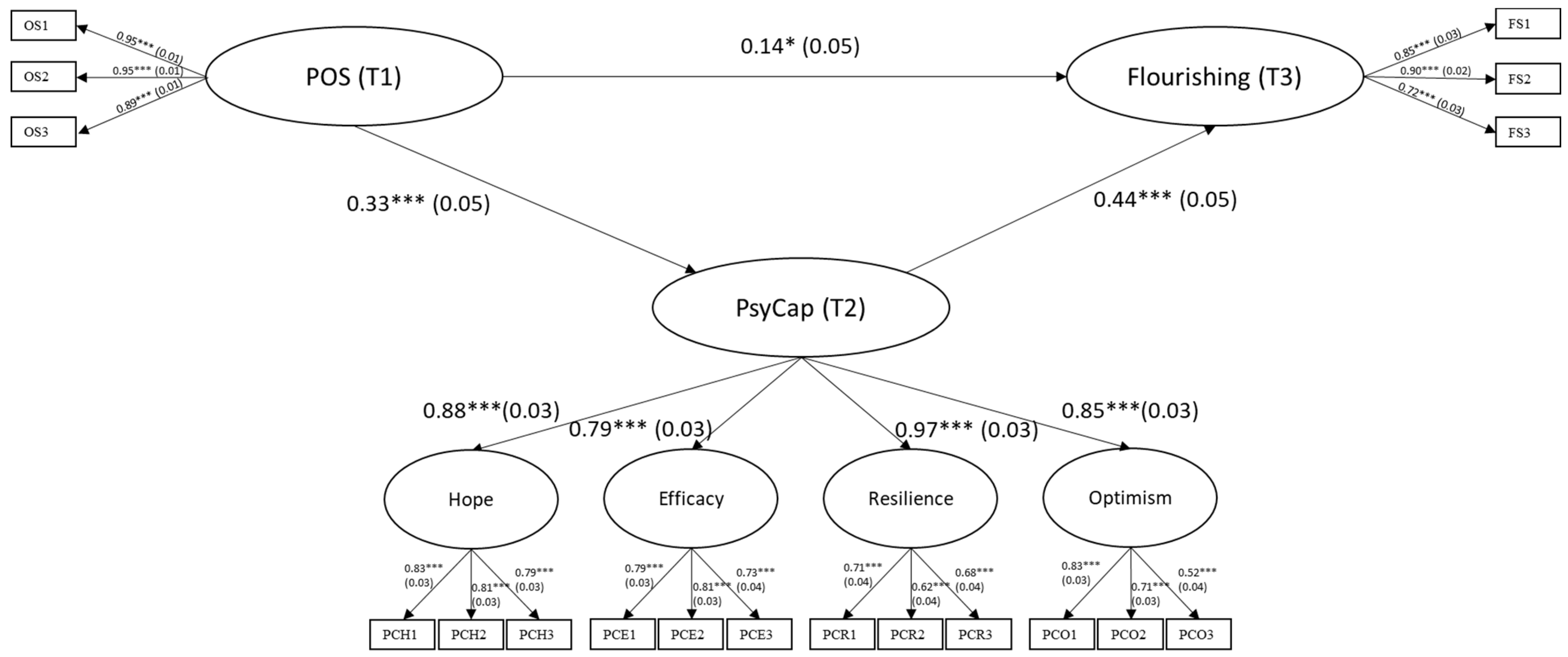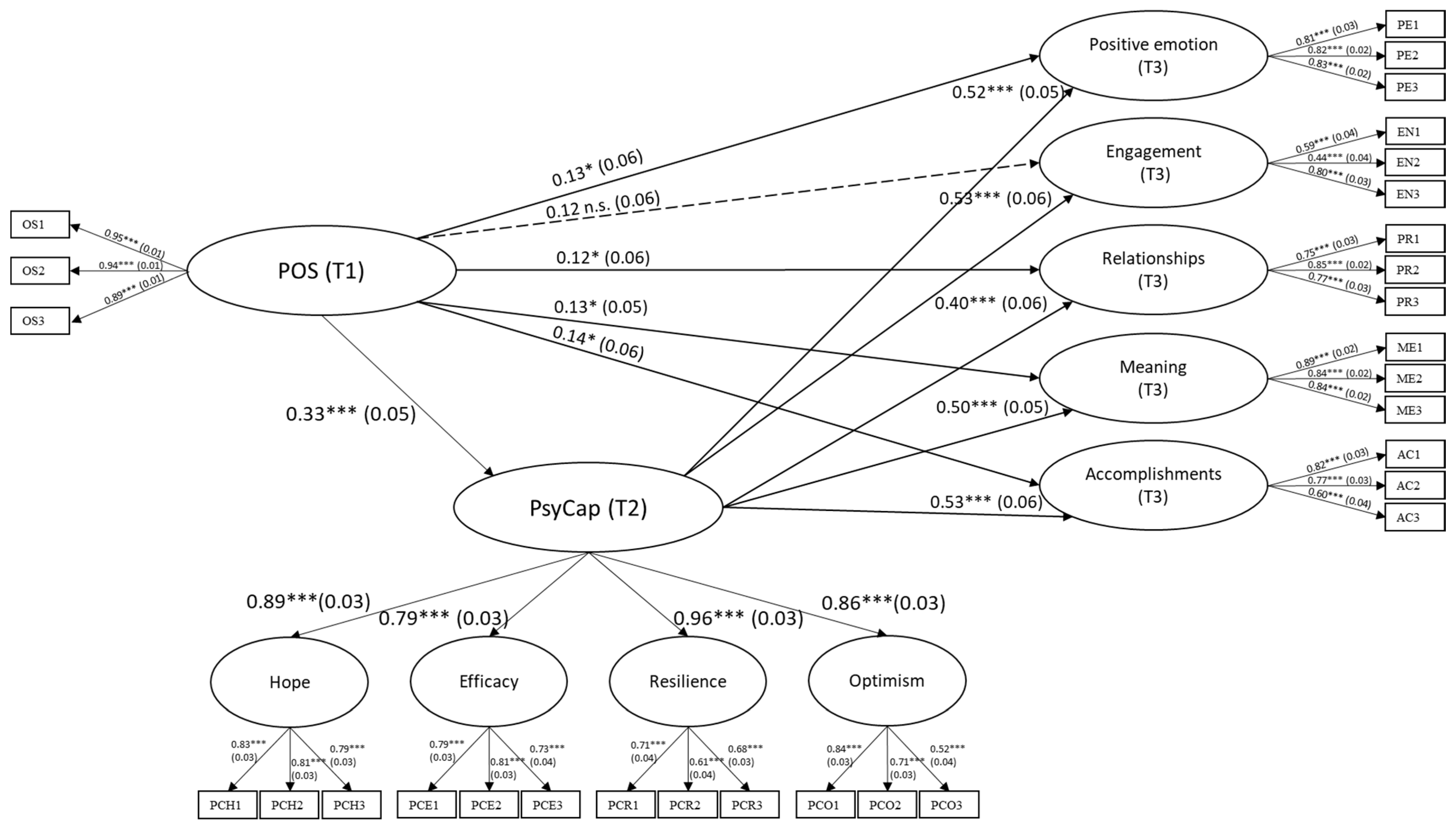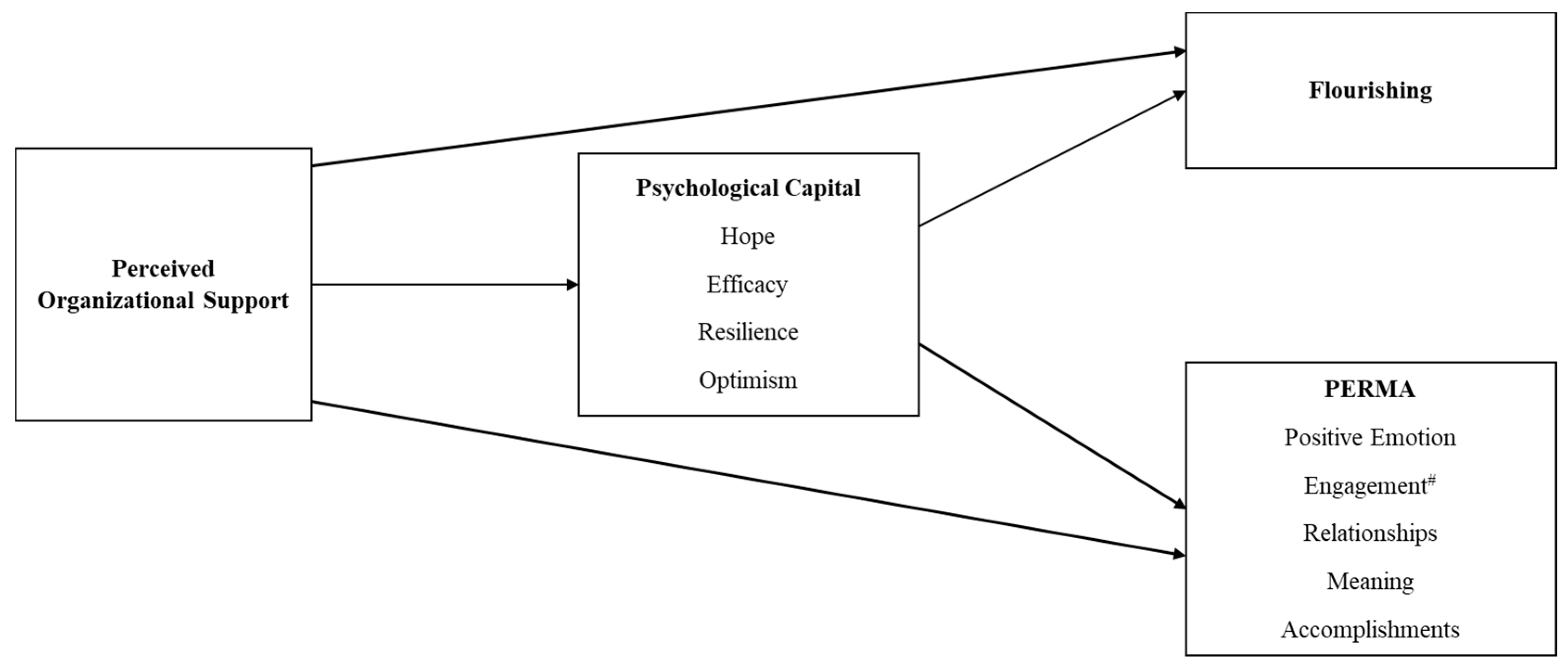Flourishing in the Workplace: A One-Year Prospective Study on the Effects of Perceived Organizational Support and Psychological Capital
Abstract
:1. Introduction
1.1. Theoretical Background of Psychological Capital
1.2. Organizational and Personal Resources for Flourishing
1.3. Present Study
2. Methods
2.1. Participants and Procedures
2.2. Measures
2.3. Data Analysis
3. Results
3.1. Inter-Correlations
3.2. Measurement Model
3.3. Structural Model
4. Discussion
Limitations
5. Conclusions
Author Contributions
Funding
Institutional Review Board Statement
Informed Consent Statement
Data Availability Statement
Acknowledgments
Conflicts of Interest
References
- World Health Organization. Burn-Out an “Occupational Phenomenon”: International Classification of Diseases. 2019. Available online: https://www.who.int/news/item/28-05-2019-burn-out-an-occupational-phenomenon-international-classification-of-diseases (accessed on 2 July 2021).
- Kisi. 2020 Work-Life Balance Index: Cities with the Best Work-Life Balance. 2020. Available online: https://www.getkisi.com/work-life-balance-2020#table (accessed on 2 July 2021).
- Occupational Safety & Health Council. Survey Report on Awareness of Occupational Stress in Hong Kong; Occupational Safety & Health Council: Hong Kong, China, 2002. [Google Scholar]
- Occupational Safety & Health Council. Preliminary Survey on Occupational Burnout in Hong Kong Workplaces; Occupational Safety & Health Council: Hong Kong, China, 2018. [Google Scholar]
- Cropanzano, R.; Wright, T.A. When a ‘happy’ worker is really a ‘productive’ worker: A review and further refinement of the happy-productive worker thesis. Consult. Psychol. J. Pract. Res. 2001, 53, 182–199. [Google Scholar] [CrossRef]
- Diener, E.; Wirtz, D.; Tov, W.; Kim-Prieto, C.; Choi, D.-W.; Oishi, S.; Biswas-Diener, R. New well-being measures: Short scales to assess flourishing and positive and negative feelings. Soc. Indic. Res. 2010, 97, 143–156. [Google Scholar] [CrossRef]
- Seligman, M.E.P. Flourish: A Visionary New Understanding of Happiness and Well-Being; Free Press: New York, NY, USA, 2011. [Google Scholar]
- Butler, J.; Kern, M.L. The PERMA-Profiler: A brief multidimensional measure of flourishing. Int. J. Wellbeing 2016, 6, 1–48. [Google Scholar] [CrossRef] [Green Version]
- Luthans, F. The need for and meaning of positive organizational behavior. J. Organ. Behav. 2002, 23, 695–706. [Google Scholar] [CrossRef] [Green Version]
- Bakker, A.B.; Schaufeli, W.B. Positive organizational behavior: Engaged employees in flourishing organizations. J. Organ. Behav. 2008, 29, 147–154. [Google Scholar] [CrossRef]
- Luthans, F.; Youssef-Morgan, C.M. Psychological capital: An evidence-based positive approach. Annu. Rev. Organ. Psychol. Organ. Behav. 2017, 4, 339–366. [Google Scholar] [CrossRef] [Green Version]
- Luthans, F.; Avolio, B.J.; Avey, J.B.; Norman, S.M. Positive psychological capital: Measurement and relationship with performance and satisfaction. Pers. Psychol. 2007, 60, 541–572. [Google Scholar] [CrossRef] [Green Version]
- Avey, J.B.; Reichard, R.J.; Luthans, F.; Mhatre, K.H. Meta-analysis of the impact of positive psychological capital on employee attitudes, behaviors, and performance. Hum. Resour. Dev. Q. 2011, 22, 127–152. [Google Scholar] [CrossRef] [Green Version]
- Mazzetti, G.; Guglielmi, D.; Chiesa, R.; Mariani Marco, G. Happy employees in a resourceful workplace: Just a direct relationship? A study on the mediational role of psychological capital. Career Dev. Int. 2016, 21, 682–696. [Google Scholar] [CrossRef]
- Siu, O.L.; Cheung, F.; Lui, S. Linking positive emotions to work well-being and turnover intention among Hong Kong police officers: The role of psychological capital. J. Happiness Stud. 2015, 16, 367–380. [Google Scholar] [CrossRef]
- Ho, H.C.Y.; Chan, Y.C. The impact of psychological capital on well-being of social workers: A mixed-methods investigation. Soc. Work, 2021; in press. [Google Scholar]
- Hobfoll, S.E.; Halbesleben, J.; Neveu, J.-P.; Westman, M. Conservation of resources in the organizational context: The reality of resources and their consequences. Annu. Rev. Organ. Psychol. Organ. Behav. 2018, 5, 103–128. [Google Scholar] [CrossRef] [Green Version]
- Ho, H.C.Y.; Chui, O.S.; Chan, Y.C. When pandemic interferes with work: Psychological capital and mental health of social workers during COVID-19. Soc. Work, 2021; in press. [Google Scholar]
- Ho, H.C.Y.; Chan, Y.C. Longitudinal associations between psychological capital and problem-solving among social workers: A two-wave cross-lagged study. Health Soc. Care Community, 2022; in press. [Google Scholar]
- Salanova, M.; Schaufeli, W.B.; Xanthopoulou, D.; Bakker, A.B. The gain spiral of resources and work engagement: Sustaining a positive worklife. In Work Engagement: A Handbook of Essential Theory and Research; Psychology Press: London, UK, 2010; pp. 118–131. [Google Scholar]
- Kurtessis, J.N.; Eisenberger, R.; Ford, M.T.; Buffardi, L.C.; Stewart, K.A.; Adis, C.S. Perceived organizational support: A meta-analytic evaluation of organizational support theory. J. Manag. 2017, 43, 1854–1884. [Google Scholar] [CrossRef] [Green Version]
- Eisenberger, R.; Shanock, L.R.; Wen, X. Perceived organizational support: Why caring about employees counts. Annu. Rev. Organ. Psychol. Organ. Behav. 2020, 7, 101–124. [Google Scholar] [CrossRef] [Green Version]
- Liu, L.; Hu, S.; Wang, L.; Sui, G.; Ma, L. Positive resources for combating depressive symptoms among Chinese male correctional officers: Perceived organizational support and psychological capital. BMC Psychiatry 2013, 13, 89. [Google Scholar] [CrossRef] [PubMed] [Green Version]
- Nielsen, K.; Nielsen, M.B.; Ogbonnaya, C.; Känsälä, M.; Saari, E.; Isaksson, K. Workplace resources to improve both employee well-being and performance: A systematic review and meta-analysis. Work Stress 2017, 31, 101–120. [Google Scholar] [CrossRef] [Green Version]
- Podsakoff, P.M.; MacKenzie, S.B.; Lee, J.-Y.; Podsakoff, N.P. Common method biases in behavioral research: A critical review of the literature and recommended remedies. J. Appl. Psychol. 2003, 88, 879–903. [Google Scholar] [CrossRef]
- Maxwell, S.E.; Cole, D.A. Bias in cross-sectional analyses of longitudinal mediation. Psychol. Methods 2007, 12, 23–44. [Google Scholar] [CrossRef] [Green Version]
- Census and Statistics Department. Statistical Digest of the Services Sector; Census and Statistics Department: Hong Kong, China, 2020. Available online: https://www.statistics.gov.hk/pub/B10800072020AN20B0100.pdf (accessed on 2 July 2021).
- Soper, D.S. A-Priori Sample Size Calculator for Structural Equation Models [Software]. 2017. Available online: http://www.danielsoper.com/statcalc (accessed on 28 December 2017).
- Eisenberger, R.; Huntington, R.; Hutchison, S.; Sowa, D. Perceived organizational support. J. Appl. Psychol. 1986, 71, 500. [Google Scholar] [CrossRef]
- Newman, A.; Thanacoody, R.; Hui, W. The effects of perceived organizational support, perceived supervisor support and intra-organizational network resources on turnover intentions: A study of Chinese employees in multinational enterprises. Pers. Rev. 2012, 41, 56–72. [Google Scholar] [CrossRef] [Green Version]
- Siu, O.L. Psychological capital, work well-being, and work-life balance among Chinese employees: A cross-lagged analysis. J. Pers. Psychol. 2013, 12, 170–181. [Google Scholar] [CrossRef]
- Tang, X.; Duan, W.; Wang, Z.; Liu, T. Psychometric evaluation of the simplified Chinese version of Flourishing Scale. Res. Soc. Work. Pract. 2016, 26, 591–599. [Google Scholar] [CrossRef]
- Graham, J.W. Missing data analysis: Making it work in the real world. Annu. Rev. Psychol. 2009, 60, 549–576. [Google Scholar] [CrossRef] [Green Version]
- Graham, J.W.; Hofer, S.M.; MacKinnon, D.P. Maximizing the usefulness of data obtained with planned missing value patterns: An application of maximum likelihood procedures. Multivar. Behav. Res. 1996, 31, 197–218. [Google Scholar] [CrossRef] [PubMed]
- Rubin, D.B. Multiple Imputation for Nonresponse in Surveys; Wiley: New York, NY, USA, 1987. [Google Scholar]
- Rogers, W.M.; Schmitt, N. Parameter recovery and model fit using multidimensional composites: A comparison of four empirical parceling algorithms. Multivar. Behav. Res. 2004, 39, 379–412. [Google Scholar] [CrossRef]
- Preacher, K.J.; Hayes, A.F. SPSS and SAS procedures for estimating indirect effects in simple mediation models. Behav. Res. Methods Instrum. Comput. 2004, 36, 717–731. [Google Scholar] [CrossRef] [Green Version]
- Hu, L.T.; Bentler, P.M. Cutoff criteria for fit indexes in covariance structure analysis: Conventional criteria versus new alternatives. Struct. Equ. Modeling 1999, 6, 1–55. [Google Scholar] [CrossRef]
- Caesens, G.; Stinglhamber, F.; Ohana, M. Perceived organizational support and well-being: A weekly study. J. Manag. Psychol. 2016, 31, 1214–1230. [Google Scholar] [CrossRef]
- Hayton, J.C.; Carnabuci, G.; Eisenberger, R. With a little help from my colleagues: A social embeddedness approach to perceived organizational support. J. Organ. Behav. 2012, 33, 235–249. [Google Scholar] [CrossRef]
- Wang, M.-L. Does organizational support promote citizenship in service settings? The moderating role of service climate. J. Soc. Psychol. 2009, 149, 648–676. [Google Scholar] [CrossRef] [PubMed]
- Bhatnagar, J.; Aggarwal, P. Meaningful work as a mediator between perceived organizational support for environment and employee eco-initiatives, psychological capital and alienation. Empl. Relat. 2020, 42, 1487–1511. [Google Scholar] [CrossRef]
- Karatepe, O.M. Perceived organizational support, career satisfaction, and performance outcomes: A study of hotel employees in Cameroon. Int. J. Contemp. Hosp. Manag. 2012, 24, 735–752. [Google Scholar] [CrossRef]
- Patrick, A.; Laschinger, H.K.S. The effect of structural empowerment and perceived organizational support on middle level nurse managers’ role satisfaction. J. Nurs. Manag. 2006, 14, 13–22. [Google Scholar] [CrossRef]
- Colquitt, J.A. On the dimensionality of organizational justice: A construct validation of a measure. J. Appl. Psychol. 2001, 86, 386–400. [Google Scholar] [CrossRef] [PubMed] [Green Version]
- Körner, M.; Wirtz, M.A.; Bengel, J.; Göritz, A.S. Relationship of organizational culture, teamwork and job satisfaction in interprofessional teams. BMC Health Serv. Res. 2015, 15, 243. [Google Scholar] [CrossRef] [Green Version]
- Goodman, F.R.; Disabato, D.J.; Kashdan, T.B.; Kauffman, S.B. Measuring well-being: A comparison of subjective well-being and PERMA. J. Posit. Psychol. 2018, 13, 321–332. [Google Scholar] [CrossRef]
- Seligman, M. PERMA and the building blocks of well-being. J. Posit. Psychol. 2018, 13, 333–335. [Google Scholar] [CrossRef]
- Sutton, T.M.; Edlund, J.E. Assessing self-selection bias as a function of experiment title and description: The effect of emotion and personality. N. Am. J. Psychol. 2019, 21, 407–422. [Google Scholar]
- Caputo, A. Social desirability bias in self-reported well-being measures: Evidence from an online survey. Univ. Psychol. 2017, 16, 245–255. [Google Scholar] [CrossRef] [Green Version]
- Weldring, T.; Smith, S.M.S. Patient-Reported Outcomes (PROs) and Patient-Reported Outcome Measures (PROMs). Health Serv. Insights 2013, 6, 61–68. [Google Scholar] [CrossRef] [PubMed]
- Avey, J.B.; Luthans, F.; Smith, R.M.; Palmer, N.F. Impact of positive psychological capital on employee well-being over time. J. Occup. Health Psychol. 2010, 15, 17. [Google Scholar] [CrossRef] [Green Version]
- Rhoades, L.; Eisenberger, R. Perceived organizational support: A review of the literature. J. Appl. Psychol. 2002, 87, 698. [Google Scholar] [CrossRef] [PubMed]
- Hammer, A.; Arah, O.A.; Dersarkissian, M.; Thompson, C.A.; Mannion, R.; Wagner, C.; Ommen, O.; Sunol, R.; Pfaff, H. The relationship between social capital and quality management systems in European hospitals: A quantitative study. PLoS ONE 2013, 8, e85662. [Google Scholar] [CrossRef]
- Kristensen, S.; Hammer, A.; Bartels, P.; Suñol, R.; Groene, O.; Thompson, C.A.; Arah, O.A.; Kutaj-Wasikowska, H.; Michel, P.; Wagner, C. Quality management and perceptions of teamwork and safety climate in European hospitals. Int. J. Qual. Health Care 2015, 27, 499–506. [Google Scholar] [CrossRef]
- Luthans, F.; Avey, J.B.; Avolio, B.J.; Peterson, S.J. The development and resulting performance impact of positive psychological capital. Hum. Resour. Dev. Q. 2010, 21, 41–67. [Google Scholar] [CrossRef] [Green Version]
- Lupșa, D.; Vîrga, D.; Maricuțoiu, L.P.; Rusu, A. Increasing psychological capital: A pre-registered meta-analysis of controlled interventions. Appl. Psychol. Int. Rev. 2020, 69, 1506–1556. [Google Scholar] [CrossRef]



| 1 | 2 | 3 | 4 | 5 | 6 | 7 | |
|---|---|---|---|---|---|---|---|
| |||||||
| 0.32 *** | ||||||
| 0.27 *** | 0.43 *** | |||||
| 0.30 *** | 0.47 *** | 0.73 *** | ||||
| 0.21 *** | 0.39 *** | 0.65 *** | 0.66 *** | |||
| 0.25 *** | 0.36 *** | 0.64 *** | 0.69 *** | 0.59 *** | ||
| 0.29 *** | 0.47 *** | 0.78 *** | 0.76 *** | 0.68 *** | 0.73 *** | |
| 0.29 *** | 0.49 *** | 0.62 *** | 0.67 *** | 0.70 *** | 0.52 *** | 0.66 *** |
| Fit Index | Measurement Model | Structural Model | ||
|---|---|---|---|---|
| Flourishing | PERMA | Flourishing | PERMA | |
| χ2 | 151.42 | 356.45 | 212.07 | 431.14 |
| DF | 128 | 380 | 192 | 476 |
| p | 0.08 | 0.80 | 0.15 | 0.93 |
| CFI | 0.99 | 1.00 | 0.99 | 1.00 |
| TLI | 0.99 | 1.00 | 0.99 | 1.00 |
| RMSEA | 0.02 | 0.00 | 0.02 | 0.00 |
| SRMR | 0.04 | 0.04 | 0.04 | 0.04 |
| Model | Independent Variable | Dependent Variable | Direct Effect | Indirect Effect (PsyCap as Mediator) | |||
|---|---|---|---|---|---|---|---|
| β | p | β | p | (95% CI) | |||
| Model 1 | POS T1 | Flourishing T3 | 0.14 | 0.01 | 0.15 | <0.001 | (0.09, 0.20) |
| POS T1 | PsyCap T2 | 0.33 | <0.001 | ||||
| PsyCap T2 | Flourishing T3 | 0.44 | <0.001 | ||||
| Model 2 | POS T1 | Positive Emotion T3 | 0.13 | 0.02 | 0.17 | <0.001 | (0.11, 0.24) |
| POS T1 | Engagement T3 | 0.12 | 0.06 | 0.18 | <0.001 | (0.11, 0.25) | |
| POS T1 | Relationships T3 | 0.12 | 0.04 | 0.14 | <0.001 | (0.08, 0.19) | |
| POS T1 | Meaning T3 | 0.13 | 0.01 | 0.17 | <0.001 | (0.11, 0.23) | |
| POS T1 | Accomplishments T3 | 0.14 | 0.01 | 0.18 | <0.001 | (0.11, 0.24) | |
| POS T1 | PsyCap T2 | 0.33 | <0.001 | ||||
| PsyCap T2 | Positive Emotion T3 | 0.52 | <0.001 | ||||
| PsyCap T2 | Engagement T3 | 0.53 | <0.001 | ||||
| PsyCap T2 | Relationships T3 | 0.40 | <0.001 | ||||
| PsyCap T2 | Meaning T3 | 0.50 | <0.001 | ||||
| PsyCap T2 | Accomplishments T3 | 0.53 | <0.001 | ||||
Publisher’s Note: MDPI stays neutral with regard to jurisdictional claims in published maps and institutional affiliations. |
© 2022 by the authors. Licensee MDPI, Basel, Switzerland. This article is an open access article distributed under the terms and conditions of the Creative Commons Attribution (CC BY) license (https://creativecommons.org/licenses/by/4.0/).
Share and Cite
Ho, H.C.Y.; Chan, Y.C. Flourishing in the Workplace: A One-Year Prospective Study on the Effects of Perceived Organizational Support and Psychological Capital. Int. J. Environ. Res. Public Health 2022, 19, 922. https://doi.org/10.3390/ijerph19020922
Ho HCY, Chan YC. Flourishing in the Workplace: A One-Year Prospective Study on the Effects of Perceived Organizational Support and Psychological Capital. International Journal of Environmental Research and Public Health. 2022; 19(2):922. https://doi.org/10.3390/ijerph19020922
Chicago/Turabian StyleHo, Henry C. Y., and Ying Chuen Chan. 2022. "Flourishing in the Workplace: A One-Year Prospective Study on the Effects of Perceived Organizational Support and Psychological Capital" International Journal of Environmental Research and Public Health 19, no. 2: 922. https://doi.org/10.3390/ijerph19020922
APA StyleHo, H. C. Y., & Chan, Y. C. (2022). Flourishing in the Workplace: A One-Year Prospective Study on the Effects of Perceived Organizational Support and Psychological Capital. International Journal of Environmental Research and Public Health, 19(2), 922. https://doi.org/10.3390/ijerph19020922







